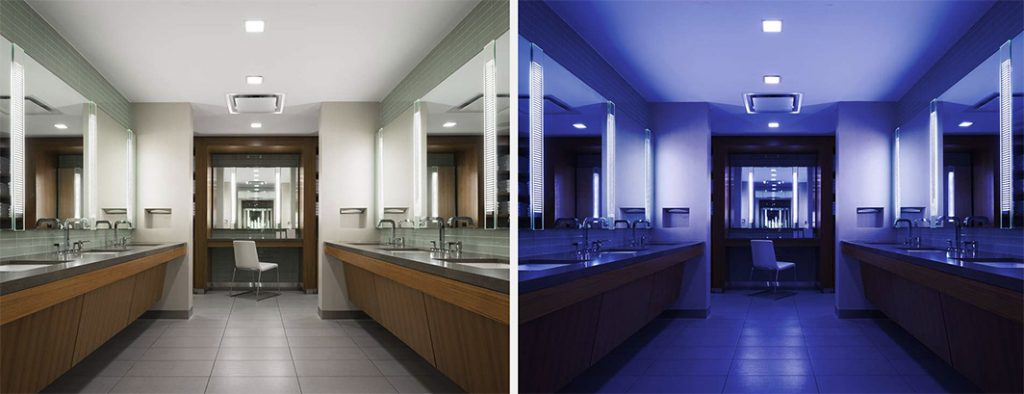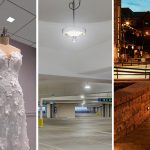The One Amazing Thing Antimicrobial Lighting Can Do That UV Can’t

In California, the historic Beverly Hilton Hotel found itself in the national spotlight once more, courtesy of new cleaning personnel they hired on the spot: a three-foot-tall robot named Kennedy.
His job? Shine UV light in spaces cleaned by human colleagues and ensure a new defense line against lurking, invisible infectious threats.
The Greater Boston Food Bank brought in similar labor, courtesy of MIT’s Computer Science and Artificial Intelligence Laboratory, which mounted a custom UV-C lamp on a mobile robot base to sanitize surfaces in the former’s warehouse. This new hire, brighter than most, garnered headlines as well.
One under-the-radar hiccup: The UV robots cannot be used when someone is around. A built-in protection feature shuts off their cleaning function whenever movement is detected, which is quite often in these settings.
It’s difficult, perhaps impossible, to guarantee endless antimicrobial and antiviral action with UV lighting when guests and staff are zigzagging across a building, entering and leaving their guestrooms and workspaces at will. Or when workers are moving crates and pallets at all hours.
Clean, antimicrobial LED lighting, however, can make such a promise—and never break it. All because it never needs to take a break, regardless of who or what is around.
This luminous new weapon in the fight against infectious diseases and the pathogenic microbes that cause them is also making a news splash—with no asterisks required.
Why UV Lighting is Toxic to You and Everyone Else
It’s easy to confuse the two—clean, antimicrobial lighting and UV lighting. They seem similar, and both check off the same objective: Decontaminate with just the right trace of light.
The difference is how they provide antibacterial action.
Let’s start with UV light, which is intrinsically dangerous and damages the cellular structure in all living creatures, including humans.
UV lighting primarily functions as an exceptionally harsh disinfectant, piercing a microbe’s nucleus and obliterating nucleic acids while disrupting DNA structures. The damaged DNA accumulates and leaves the cells incapable of performing vital essential functions. Cancerous cells often form. So does eye disease.
Simply put, UV lighting is not suitable for use when humans, pets and plants are present in a space—thus, why the robots at the Beverly Hilton Hotel and Greater Boston Food Bank have motion-sensor shutoff mechanisms to protect from UV lighting’s poisonous impact.
The question is, what can help protect you, your staff and your customers from the microorganisms in between UV lighting and your regularly scheduled or ad hoc cleaning crew rotation?
Here is a solution worth considering: antimicrobial illumination.
How Antimicrobial Lighting beats the Contamination Challenge
Clean, antimicrobial lighting uses a specific wavelength of lighting that attacks, then kills approximately 90%* of the bacteria, fungi, yeast, mold and pathogens it touches, creating an inhospitable environment on surfaces where germs and bacteria multiply, regardless of setting, including:
- Desks, keyboards and doorknobs in offices
- Plastic, rubber and stainless-steel equipment and personal gear in hospitals
- Remotes, light switches and bedsheets in hotels
- Silverware, platers and tables in restaurants
- Countertops, towels and accessories in restrooms and kitchens
- Cafeterias, classrooms, hallways and gyms in schools
This next generation of superbug-zapping illumination works 24/7 to reduce the bioburden—the number of bacteria living on a surface—and supplement continuous cleaning crew efforts to create a clean, healthier environment.
A century of research illustrates that everyday visible light can effectively reduce contamination on surfaces. Studies that link the two date back nearly 130 years to 1892 in England, where filters were used with sunlight to see how well they decontaminated.
Like UV lighting, clean, antimicrobial lighting didn’t earn widespread interior application usage until the advent and growth of LEDs for ambient illumination.
Unlike UV lighting, you can flip the switch on antimicrobial lighting and keep it on at all times of the day, even when there’s movement all around.
Let’s see why.
Why Antimicrobial Light is Approved Here, There, Everywhere
Antimicrobial lighting meets international standards for continuous and unrestricted use with people present.
Why?
Its wavelengths cluster around the 400-to-420-nanometer mark—which is outside the UV frequency range of 100 to 380 nanometers..
A general rule of thumb: More nanometers equal more wavelengths on the visible light spectrum, which ranges between 380 and 750 nanometers and is comprised of the colors we can see, like those in a crayon box. The shorter the wavelengths below 380 nanometers, the greater the danger to living things.
In other words, clean lighting’s microbial extermination power comes from within the visible light spectrum. It activates certain types of porphyrin molecules present precisely in microbial cells—but not in humans, plants or animals. When activated, the porphyrins produce excessive Reactive Oxygen Species (ROS) within the microbial cell, such as singlet oxygen, hydrogen peroxide and hydroxyl groups, destroying multiple structures within the cell.
Unlike microbial cells, the types of porphyrin molecules found in humans and other animals are not photoactivated by illumination in the 400-to-420 nanometer range, which is why antimicrobial lighting technology is approved internationally for continuous usage even when living things are crisscrossing underneath.
It’s just a more practical way to dump germs, eliminating the hassle of vacating space and interrupting workflows and relaxation to ensure a cleaner environment.
Employees and customers appreciate it, too. It’s more tangible proof of your investment in their health and wellness. Their satisfaction rises, as does your brand’s reputation and integrity.
In the race against UV lighting for top germicidal illumination bragging rights, antimicrobial LED lighting gives you a jump on the one thing UV can’t: Provide your environment with continuous antimicrobial action—without anyone ever having to leave.
Want to learn more?
To learn more about how clean LED lighting is at the front lines in the fight to combat illness, read: “Amerlux Inks Partnership with Vyv to Offer Antimicrobial Lighting.”
*Testing on a non-enveloped virus (MS2 bacteriophage) showed a 99.985% reduction in controlled laboratory testing in six hours on hard surfaces. MRSA and E. coli showed 90%+ reduction in controlled laboratory testing in 24 hours on hard surfaces. Results may vary depending on the amount of light that is reaching the surfaces in the space where the product is installed and the length of time of exposure. The use of ActiveClean antimicrobial light is not intended to replace manual cleaning.

